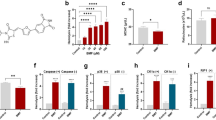Abstract
Endothelial monocyte-activating polypeptide-II (EMAP-II), a proinflammatory cytokine with antiangiogenic properties, renders tumours sensitive to tumour necrosis factor-alpha (TNF) treatment. The exact mechanisms for this effect remain unclear. Here we show that human endothelial cells (EC) are insensitive to TNF-induced apoptosis but after a short pre-treatment with EMAP-II, EC quickly undergo TNF-induced apoptosis. We further analysed this EMAP-II pre-treatment effect and found no increase of TNF-R1 protein expression but rather an induction of TNF-R1 redistribution from Golgi storage pools to cell membranes. In addition, we observed EMAP-II induced mobilization and membrane expression of the TNF-R1-Associated Death Domain (TRADD) protein. Immunofluorescence co-staining experiments revealed that these two effects occurred at the same time in the same cell but TNF-R1 and TRADD were localized in different vesicles. These findings suggest that EMAP-II sensitises EC to apoptosis by facilitating TNF-R1 apoptotic signalling via TRADD mobilization and introduce a molecular and antiangiogenic explanation for the TNF sensitising properties of EMAP-II in tumours.
Similar content being viewed by others
References
Murray JC, Clauss M, Denekamp J, Stern D (1991) Selective induction of endothelial cell tissue factor in the presence of a tumour-derived mediator: a potential mechanism of flavone acetic acid action in tumour vasculature. Int J Cancer 49:254–59
Kao J, Ryan J, Brett G et al (1992) Endothelial monocyte-activating polypeptide II. A novel tumor-derived polypeptide that activates host-response mechanisms. J Biol Chem 267:20239–0247
Schwarz MA, Kandel J, Brett J et al (1999) Endothelial-monocyte activating polypeptide II, a novel antitumor cytokine that suppresses primary and metastatic tumor growth and induces apoptosis in growing endothelial cells. J Exp Med 190:341–54
Chang SY, Ko HJ, Heo TH, Kang CY (2005) Heparan sulfate regulates the antiangiogenic activity of endothelial monocyte-activating polypeptide-II at acidic pH. Mol Pharmacol 67:1534–543
Schwarz MA, Zheng H, Liu J, Corbett S, Schwarz RE (2005) Endothelial-monocyte activating polypeptide II alters fibronectin based endothelial cell adhesion and matrix assembly via alpha5 beta1 integrin. Exp.Cell Res 311:229–39
Murray JC, Symonds P, Ward W et al (2004) Colorectal cancer cells induce lymphocyte apoptosis by an endothelial monocyte-activating polypeptide-II-dependent mechanism. J Immunol 172:274–81
Wu PC, Alexander HR, Huang J et al (1999) In vivo sensitivity of human melanoma to tumor necrosis factor (TNF)-alpha is determined by tumor production of the novel cytokine endothelial-monocyte activating polypeptide II (EMAPII). Cancer Res 59:205–2
Gnant MF, Berger AC, Huang J et al (1999) Sensitization of tumor necrosis factor alpha-resistant human melanoma by tumor-specific in vivo transfer of the gene encoding endothelial monocyte-activating polypeptide II using recombinant vaccinia virus. Cancer Res 59:4668–674
Lans TE, ten Hagen TL, Van Horssen R et al (2002) Improved antitumor response to isolated limb perfusion with tumor necrosis factor after upregulation of endothelial monocyte-activating polypeptide II in soft tissue sarcoma. Annals Surg Oncol 9:812–19
Berger AC, Alexander HR, Wu PC et al (2000) Tumour necrosis factor receptor I (p55) is upregulated on endothelial cells by exposure to the tumour-derived cytokine endothelial monocyte- activating polypeptide II (EMAP-II). Cytokine 12:992–000
Tandle AT, Mazzanti C, Alexander HR, Roberts DD, Libutti SK (2005) Endothelial monocyte activating polypeptide-II induced gene expression changes in endothelial cells. Cytokine 30:347–58
Ashkenazi A, Dixit VM (1998) Death receptors: signaling and modulation. Science 281:1305–308
Tartaglia LA, Goeddel DV (1992) Two TNF receptors. Immunol Today 13:151–53
Jones SJ, Ledgerwood EC, Prins JB et al (1999) TNF recruits TRADD to the plasma membrane but not the trans-Golgi network, the principal subcellular location of TNF-R1. J Immunol 162:1042–048
Baud V, Karin M (2001) Signal transduction by tumor necrosis factor and its relatives. Trends Cell Biol 11:372–77
Micheau O, Tschopp J (2003) Induction of TNF receptor I-mediated apoptosis via two sequential signaling complexes. Cell 114:181–90
Schneider-Brachert W, Tchikov V, Neumeyer J et al (2004) Compartmentalization of TNF receptor 1 signaling: internalized TNF receptosomes as death signaling vesicles. Immunity 21:415–28
Harper N, Hughes M, MacFarlane M, Cohen GM (2003) Fas-associated death domain protein and caspase-8 are not recruited to the tumor necrosis factor receptor 1 signaling complex during tumor necrosis factor-induced apoptosis. J Biol Chem 278:25534–5541
Eggermont AM, de Wilt JH, ten Hagen TL (2003) Current uses of isolated limb perfusion in the clinic and a model system for new strategies. Lancet Oncol 4:429–37
Lejeune FJ, Lienard D, Eggermont AMM et al (1994) Rationale for using TNF alpha and chemotherapy in regional therapy of melanoma. J Cell Biochem 56:52–1
Van Horssen R, Rens JAP, Brunstein F et al (2006) Intratumoural expression of TNF-R1 and EMAP-II in relation to response of patients treated with TNF-based isolated limb perfusion. Int J Cancer 119:1481–490
Berger AC, Alexander HR, Tang G et al (2000) Endothelial monocyte activating polypeptide II induces endothelial cell apoptosis and may inhibit tumor angiogenesis. Microvasc Res 60:70–0
Stoelcker B, Ruhland B, Hehlgans T, Bluethmann H, Luther T, Mannel DN (2000) Tumor necrosis factor induces tumor necrosis via tumor necrosis factor receptor type 1-expressing endothelial cells of the tumor vasculature. Am J Pathol 156:1171–176
Li X, Minden A (2005) Pak4 functions in TNFalpha induced survival pathways by facilitating TRADD binding to the TNF receptor. J Biol Chem 280:41192–1200
Author information
Authors and Affiliations
Corresponding author
Rights and permissions
About this article
Cite this article
Horssen, R.v., Rens, J.A.P., Schipper, D. et al. EMAP-II facilitates TNF-R1 apoptotic signalling in endothelial cells and induces TRADD mobilization. Apoptosis 11, 2137–2145 (2006). https://doi.org/10.1007/s10495-006-0284-5
Published:
Issue Date:
DOI: https://doi.org/10.1007/s10495-006-0284-5




